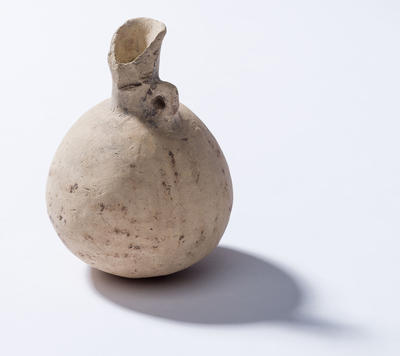Vessel, Bottle, White Painted Ware
Country
Cyprus
See full details
Object detail
Description
White painted ware bottle. Depressed globular body with rounded base. Narrow concave sided neck, swelling upward to horizontal mouth with slightly flaring rim.Small angular string hole handle, circular in section, from lower neck to shoulder. Buff grey clay with grits and straw imprints, covered with thick cream-buff slip. Very feint traces of decoration on dark brown paint. Parallel vertical bands on shoulder below and opposite handle pendant to lower body in between bands of very indistinct horizontal decoration. Possibly concentric circles on base. Solid paint on handle. Area of rim and upper neck missing. (Webb, Jennifer M., "Corpus of Cypriote Antiquities", Studies in Mediterranean Archaeology, Vol. XX: p.7)
Classification
DOMESTIC EQUIPMENT Food and Drink Consumption flask
ARCHAEOLOGY Cypriot flask
ARCHAEOLOGY Cypriot flask
Production place
Measurements
L110mm x W77mm x D75mm
Media/Materials description
Pottery, buff grey clay with grits and straw imprints, covered with thick cream-buff slip
Signature/Marks
decoration
History and use
Pottery is one of the most abundant, common and enduring artefacts in the ancient record, and one of human kinds most fundamental technologies. The craft or making pottery was widespread throughout the ancient world. Pottery was widespread as it was cheap to make, malleable into various forms and watertight after firing. Potters learnt the craft over several years – digging local clay, removing stones and roots, passing it through mesh, mixing with water and settling, cutting into squares, kneading to remove air pockets, forming the vessel, and firing. Vessels can be made using various methods, including pinch, coil, slab, paddle and anvil, and wheel or mould. It can be relatively plain, or decorated by using impressed designs, slips, paints, and even applying mould-made figures. Plain ware vessels are often under-reported in comparison to the more highly decorated vessels. Domestic pottery changed little in form and was largely undecorated – reflecting the ‘form and function’ approach and everyday utility of these vessels.
Associated person
Registration number
H667



